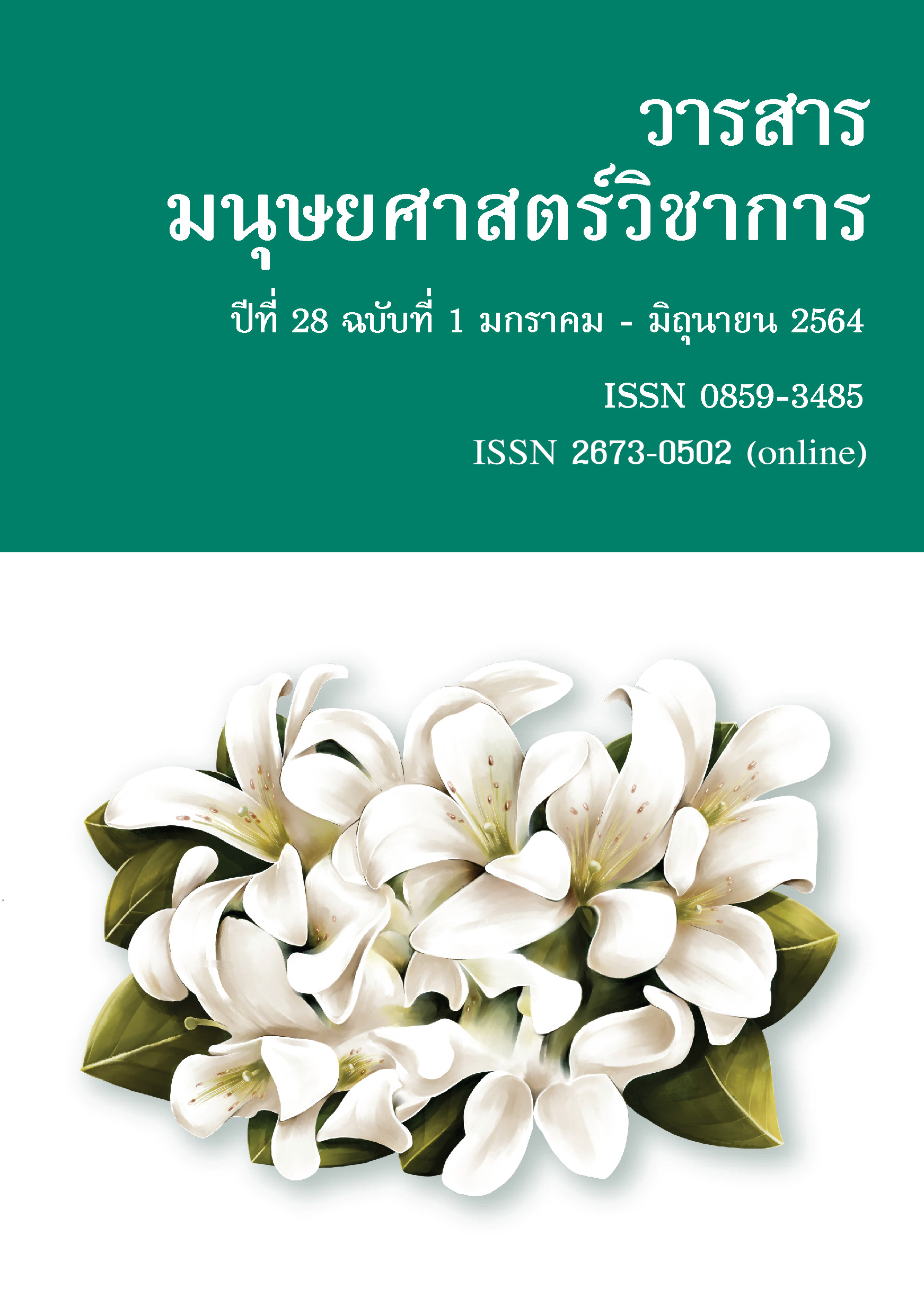Conceptual Metaphor of [FEAR] in Literary Work: A Case Study of the Short Story Entitled ‘/sa.ŋòp ŋōŋ nāj dōŋ ŋūu/’ (Confused Calmness in Snakes’ Wilderness)
Main Article Content
Abstract
This research article aims to analyze the conceptual metaphor of [FEAR] in the short story named ‘/sa.ŋòp ŋōŋ nāj dōŋ ŋūu/’ (Confused Calmness in Snakes’ Wilderness) by means of the theory of conceptual metaphor in cognitive linguistics, which can be applied to analyze linguist ic forms and features in both ordinary and creative language expressing human beings’ experience. The findings were that the conceptual metaphors of [FEAR] could be divided into 14 categories: 1) [FEAR IS DENSE FOREST] 2) [FEAR IS
LEAF FALL] 3) [FEAR IS UGLINESS] 4) [FEAR IS ELECTION] 5) [FEAR IS CONTROL] 6) [FEAR IS DISEASE] 7) [FEAR IS ROPE] 8) [FEAR IS DEATH] 9) [FEAR IS ORGAN] 10) [FEAR IS OBJECT] 11) [FEAR IS SOUL] 12) [FEAR
IS VENOM] 13) [FEAR IS HUMAN], and 14) [FEAR IS SNAKE]. The effects of the use of conceptual metaphor show that the characters (human beings) have a wide variety of fears emerging from diverse worldviews. These conceptualizations, therefore, reflect the thought processes of comparison in the actual language used in a work in the literary genre the short story and make it possible to adequately see the relationships among the dimensions of language, thought, and text. That is to say, the text is a space for presenting
events related to human activity involving the exercise of power among members of one society, which is a community in the process of electing a leader and thus shows the workings of local politics. Still, conflicts bring about competition which appears in the language of campaigning and conversational interchanges in which thoughts involving comparisons are communicated to lend support or launch attacks, and these appear in the form of conceptual metaphors, which, in the main character, evoke fear more than courage in the election battlefield and provide a true mirror of human life.
Article Details
References
จันทรา รัศมีทอง. (2559). สงบงงในดงงู. ใน วรรณกรรมรางวัลพานแว่นฟ้า ประจำปี 2559 (น. 23-45). กรุงเทพฯ: สำนักงานเลขาธิการสภาผู้แทนราษฎร.
ณรงค์กรรณ รอดทรัพย์ อัญชลี วงศ์วัฒนา และพัชรินทร์ อนันต์ศิริวัฒน์. (2560). อุปลักษณ์เกี่ยวกับอารมณ์กลัวในรวมเรื่องสั้นและรายการโทรทัศน์ภาษาไทย. วารสารอารยธรรมศึกษาโขง-สาละวิน, 8(2), 85-107.
นววรรณ พันธุเมธา. (2556). คำว่า มิ่งและขวัญ. สืบค้นเมื่อ 23 เมษายน 2562 จาก http://www.royin.go.th/?ebook=.
ภาพที่ 1. เรือจอดนิ่ง. สืบค้นเมื่อวันที่ 21 มิถุนายน 2564 จาก https://www.flickr.com/photos/shankaronline/49840484502.
ภาพที่ 2. คนยืนนิ่ง. สืบค้นเมื่อวันที่ 21 มิถุนายน 2564 จาก https://vectorified.com/man-standing-vector.
สิริศิระ โชคทวีกิจ. (2562). ความคิดที่เชื่อว่ามีอยู่ก่อนในเรื่องสั้น “สงบงงในดงงู”: แนวทางวาทกรรมวิเคราะห์เชิงวิพากษ์. วารสารภาษาและวัฒนธรรม, 38(1), 154-172.
Caracciolo, Macro. (2017). Creative metaphor in literature. In Elena Semino and Zsófia Demjén (Eds), The Routledge Handbook of Metaphor and Language. London & New York: Routledge.
Gavelin, E mma. (2015). Conceptual metaphors: a diachronic study of LOVE metaphors in Mariah Carey’s song lyrics. Retrieved from https://www.divaportal.org/smash/get/diva2:902296/FULLTEXT01.pdf.
Geeraets, Dirk, & Cuyckens, Hubert. (2007). Introducing Cognitive Linguistics. In Dirk Geeraets & Hubert Cuyckens (Eds.), The Oxford Handbook of Cognitive Linguistics. New York: Oxford University Press.
Grady, Joseph E. (2007). Metaphor. In Dirk Geeraets & Hubert Cuyckens (eds.), The Oxford Handbook of Cognitive Linguistics . New York: Oxford University Press.
Harrison, Chloe. (2017). Cognitive Grammar in Contemporary Fiction. Amsterdam & Philadelphia: John Benjamins. Kottasová, Ivana. (2020, 20 July). What you need to know about coronavirus on Monday, July 20 ; “Covid-19 survivors are discovering scary long-term effects of the disease. Strolls that feel like climbing Mount Everest.”. Retrieved July 22, 2020 from https://edition.cnn.com/2020/07/20/world/coronavirus-newsletter-07-20-20-intl/index.html
Kövecses, Zoltán. (2010/2002). Metaphor: A Practical Introduction (2nd ed.). Oxford: Oxford University Press.
Lakoff, George. & Johnson, Mark. (2003/1980). Metaphors We Live By. Chicago: University of Chicago Press.
Lakoff, George. & Turner, Mark. (1989). More than Cool Reason: A Field Guide to Poetic Metaphor. Chicago: University of Chicago Press.
Lee, John J. H. (2018). Russian Formalism and Its Legacy. Retrieved July 22, 2020 from https://www.academia.edu/41445184/Russian_Formalism_and_Its_Legacy. Okoro, Adedayo Deborah. (n.d.). Semantic Roles and Theta Roles. Retrieved July 22, 2020 from https://www.academia.edu/31879197/SEMANTIC_AND_THETA_ROLES.
Richards, Ivor Armstrong. (1936). The Philosophy of Rhetoric. Oxford: Oxford University Press.
Ricoeur, Paul. (1977). The Role of Metaphor: Multi-disciplinary Studies of the Creation of Meaning in Language. Toronto: University of Toronto Press.
Rohrer, Tim. (2007). Embodiment and Experientialism. In Dirk Geeraets & Hubert Cuyckens (Eds.), The Oxford Handbook of Cognitive Linguistics. New York: Oxford University Press.
Steen, Gerard J. (1994). Understanding Metaphor in Literature: An Empirical Approach. London: Longman.
Steen, Gerard J, Dorst, Aletta G. Herrmann, J. Berenike, Kaal, Anna A., Krennmayr, Tina, & Pasma, Trijntje. (2010). A Method for Linguistic Metaphor Identification: From MIP to MIPVU. Amsterdam & Philadelphia: John Benjamins


